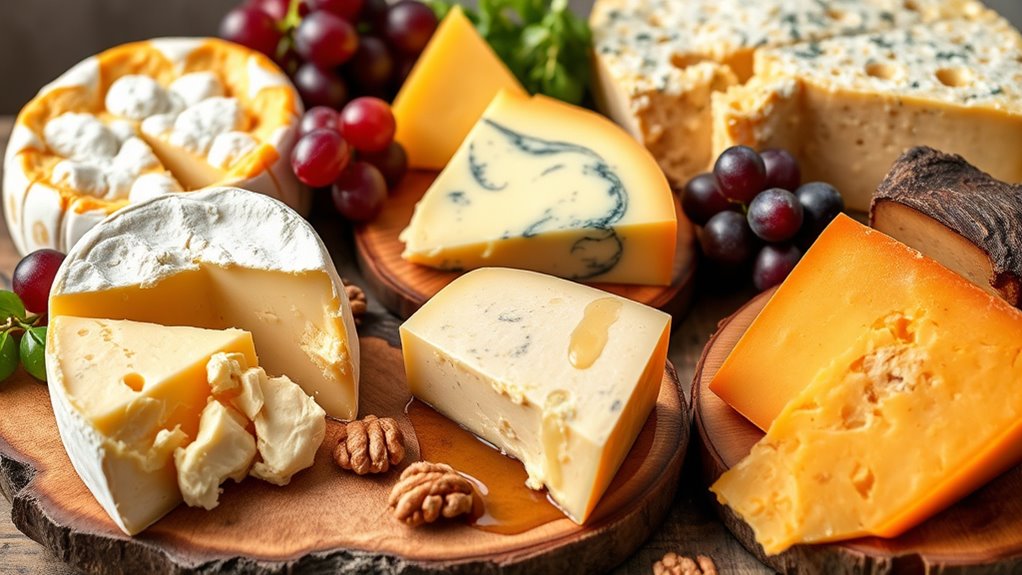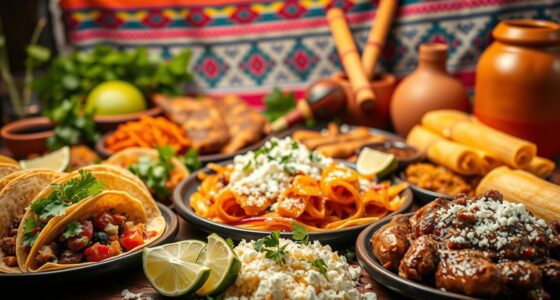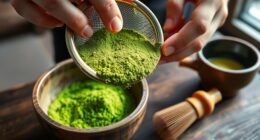Across the world, cheese reflects unique cultural traditions and craftsmanship. From France’s Brie and Camembert to Italy’s Parmesan and Mozzarella, each cheese tells a story of land, history, and methods passed down through generations. Regions influence flavor, texture, and techniques, with special practices shaping each variety. Understanding these diverse cheeses reveals much about regional identities. Keep exploring to discover more fascinating facts about cheese’s rich global heritage and traditions.
Key Takeaways
- Different regions develop unique cheese varieties reflecting local ingredients, climate, and cultural practices, such as French Brie or Italian Parmesan.
- Traditional cheese-making techniques are passed down through generations, shaping regional flavors and textures.
- Cheese often symbolizes cultural identity, history, and craftsmanship, with some protected by regional certifications like AOC.
- Fermentation, aging, and milk source influence cheese characteristics, highlighting environmental and land influences.
- Cheese plays a central role in culinary traditions worldwide, from Swiss fondue to Spanish Manchego and Italian mozzarella.

Have you ever wondered how cheese varies across different countries and cultures? It’s fascinating to see how each region’s history, climate, and local ingredients influence the types of cheese they produce. From the creamy, delicate cheeses of France to the sharp, robust varieties of Italy, cheese reflects the essence of its homeland. You might be surprised to learn that cheese isn’t just a food item; it’s a symbol of tradition, craftsmanship, and cultural identity.
Every cheese has a story, often dating back hundreds or even thousands of years, and each region’s methods have been passed down through generations. Additionally, the science behind cheese making, including fermentation and aging processes, plays a crucial role in shaping its unique characteristics.
Cheese carries centuries of tradition, passed down through generations, reflecting history and cultural heritage.
In France, cheese is deeply woven into daily life. You’re likely familiar with varieties like Brie, Camembert, and Roquefort, all crafted with meticulous care. French cheese traditions emphasize aging and terroir—meaning the environment where the cheese is made influences its flavor. These cheeses are often enjoyed with a baguette or as part of a cheese platter, highlighting their importance in French cuisine.
You mightn’t realize that many of these cheeses are protected by Appellation d’Origine Contrôlée (AOC) regulations, ensuring that the cheese you taste is authentic and made in the traditional way.
Across the border in Italy, cheese takes on a different character. Parmesan, Gorgonzola, and Mozzarella are just a few examples of Italy’s famous cheese varieties. Parmesan, or Parmigiano-Reggiano, is aged for years, developing a rich, crumbly texture and a complex umami flavor that enhances pasta dishes and risottos.
Mozzarella, often associated with pizza, is fresh and soft, produced from buffalo or cow’s milk, highlighting Italy’s dairy craftsmanship. These cheeses are integral to Italian culinary traditions, often linked to specific regions and local practices.
You’ll find that Italian cheese-making emphasizes freshness, regional specificity, and a sense of community.
In each country, cheese-making is more than just a craft; it’s a reflection of culture and history. In Switzerland, you’re likely to encounter Emmental and Gruyère, cheeses famous for their holes and nutty flavors, typically used in fondue.
In Spain, Manchego offers a firm, tangy bite, made from sheep’s milk and linked to traditional sheep herding. In each case, the techniques and ingredients tell a story about the land and its people.
Whether it’s aging methods, milk sources, or flavor profiles, cheese embodies a sense of place and heritage. The techniques used in cheese production are often influenced by traditional craftsmanship and local environmental conditions, which contribute significantly to the distinct characteristics of each cheese.
Frequently Asked Questions
How Is Cheese Traditionally Made in Different Cultures?
You’re curious about how cheese is traditionally made across cultures. In many places, people start with fresh milk, then add specific bacteria or enzymes to curdle it, shaping the curds into various forms.
Some cultures ferment the cheese longer, developing unique flavors, while others use specific salt or aging techniques. These methods reflect local traditions, ingredients, and climate, resulting in the diverse cheese varieties enjoyed worldwide.
What Are the Health Benefits of Various Types of Cheese?
Imagine cheese as a treasure chest of health benefits. Different types offer unique rewards: hard cheeses like Parmesan boost your bones with calcium, while soft cheeses provide probiotics for your gut.
Eating cheese in moderation can support your immune system, improve your mood, and supply essential nutrients.
How Do Climate and Geography Influence Cheese Varieties?
Climate and geography shape cheese varieties by determining the ingredients and aging conditions. In colder regions, you’ll find firmer, more durable cheeses like Parmesan, while warmer areas produce softer, fresher options like feta.
Mountains provide unique grasses and herbs that influence flavor, and coastal areas offer access to fresh, salty air that affects aging. You’ll notice these environmental factors create distinct textures and tastes across different cheeses worldwide.
What Are Some Unique Cheese Festivals Worldwide?
Think of cheese festivals as vibrant tapestries, each showcasing local traditions and flavors. You’ll find events like Italy’s Parmesan Festival, celebrating aged cheese with tastings and parades, or France’s Fête de la Tomme, where cheese lovers gather for workshops and music.
In the U.S., the Wisconsin Cheese Festival offers a melting pot of artisanal varieties, while the Great British Cheese Festival highlights regional specialties. These festivals make cheese history come alive!
How Do Cheese Aging Processes Vary Across Countries?
You’re curious about how cheese aging varies globally. Different countries employ unique methods: France often ages cheese in cool, humid cellars for months or years, enhancing flavor.
Italy might use specific aging rooms to develop distinct textures, while Spain’s aging can involve natural caves. Some regions add herbs or spices during aging, influencing taste and aroma.
These diverse techniques reflect local climate, culture, and tradition, creating a rich variety of cheeses worldwide.
Conclusion
As you explore cheese around the world, you’re opening a treasure chest of flavors and traditions, each bite a passport to a new culture. Just like a masterful tapestry woven with diverse threads, cheese connects history, geography, and people in a delicious dance. So, keep tasting, keep discovering—each cheese is a new chapter waiting to be written on your palate. Embrace this flavorful journey, and let every cheese be a gateway to a world of wonder.









